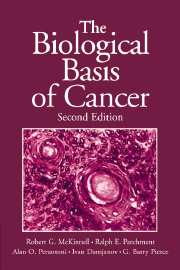Book contents
- Frontmatter
- Contents
- Preface
- Introduction: Letters illustrating clinical aspects of cancer
- 1 The pathology of cancer
- 2 Invasion and metastasis
- 3 Carcinogenesis
- 4 Genetics and heredity
- 5 Cancer-associated genes
- 6 Cancer in nonhuman organisms
- 7 Epidemiology
- 8 Lifestyle: Is there anything more important?
- 9 The stem cell basis of cancer treatment: concepts and clinical outcomes
- 10 Oncology: The difficult task of eradicating caricatures of normal tissue renewal in the human patient
- Appendix: Description of selected tumors
- Glossary
- References
- Index
- Plate section
7 - Epidemiology
Published online by Cambridge University Press: 05 June 2012
- Frontmatter
- Contents
- Preface
- Introduction: Letters illustrating clinical aspects of cancer
- 1 The pathology of cancer
- 2 Invasion and metastasis
- 3 Carcinogenesis
- 4 Genetics and heredity
- 5 Cancer-associated genes
- 6 Cancer in nonhuman organisms
- 7 Epidemiology
- 8 Lifestyle: Is there anything more important?
- 9 The stem cell basis of cancer treatment: concepts and clinical outcomes
- 10 Oncology: The difficult task of eradicating caricatures of normal tissue renewal in the human patient
- Appendix: Description of selected tumors
- Glossary
- References
- Index
- Plate section
Summary
The study of occupational, dietary, habitudinal, and other environmental cancers can point the way to measures of cancer prevention.
Julian Huxley 1958Introduction
Epidemiology is the study of the distribution, prevalence, and etiology of disease and for this book the disease is, of course, cancer. Epidemiology is studied both by observation and with experiments. This chapter is confined to observational investigations. Risk factors identified in epidemiological studies have the potential, if put to use, to prevent or lower the incidence of certain cancers. These studies include an examination of the effects of occupational exposure to carcinogens as well as lifestyle activities that tend to make certain individuals prone to cancer (lifestyle is examined in greater detail in the following chapter). A practical example, already widely recognized, relates to lung cancer and smoking. Lung cancer does not randomly afflict individuals within a population. Rather, it appears disproportionately in people who smoke cigarettes. Lung cancer differences in different groups can be, and is, correlated with different exposure to cigarette smoking. When smoking increased, so too did the incidence and deaths due to lung cancer. In the United States, smoking-induced lung cancer remains the greatest cause of death by malignancy for men and women (Figures 7–1 to 7–3; Color Plates 5 through 10). Identifying tobacco as a risk factor for lung cancer has, inherent with that knowledge, the potential for prevention of much of the disease.
- Type
- Chapter
- Information
- The Biological Basis of Cancer , pp. 221 - 247Publisher: Cambridge University PressPrint publication year: 2006



